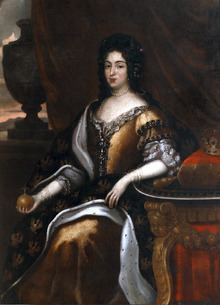Tenure 1676–1696 Mother Françoise de la Châtre | Coronation 2 February 1676 Nationality French | |
 | ||
Born 28 June 1641 ( 1641-06-28 ) Issue Jakub Ludwik Sobieski
Teresa Teofila Sobieska
Adelaide Luise Sobieska
Maria Teresa Sobieska
Teresa Kunegunda Sobieska
Aleksander Benedykt Sobieski
Konstanty Władysław Sobieski
Jan Sobieski Father Henri de la Grange d'Arquien Died 1 January 1716, Blois, France Children James Louis Sobieski, Theresa Kunegunda Sobieska Spouse John III Sobieski (m. 1665–1696), Jan Zamoyski (m. 1658–1665) Siblings Louise Marie de La Grange d'Arquien Similar John III Sobieski, James Louis Sobieski, Marie Louise Gonzaga, Theresa Kunegunda Sobieska, Jan Zamoyski | ||
Marie casimire louise de la grange d arquien
Marie Casimire Louise de La Grange d'Arquien (Polish: Maria Kazimiera d’Arquien), known also by the diminutive form "Marysieńka" (28 June 1641, Nevers – 30 January 1716, Blois) was consort to King John III Sobieski, from 1674 to 1696.
Contents
Biography
Marie Casimire and her sister were the only surviving children of Henri de la Grange d'Arquien, a French nobleman. She came to Poland at the age of five years as a lady in waiting to Marie Louise Gonzaga, the French-born Queen of Poland from 1645 to 1672, wife and consort to two Polish kings — Władysław IV Vasa and later his brother (who succeeded him) John II Casimir Vasa. At the court she met John Sobieski, who arrived there in 1656, but she was first married to Jan "Sobiepan" Zamoyski in 1658, with whom she had four children. After all of them died in infancy, Marie Casimire fell into a severe depression from which she did not recover until the following year. Zamoyski died in 1665 and just three months later, the widowed Marie Casimire married Sobieski on the 14 July the same year. The couple had fourteen children together, but only four of them survived until adult age — Jakub, Aleksander, Konstanty and Teresa (who later became Kurfürstin of Bavaria and mother to Emperor Karl VII).
John Sobieski was elected King of Poland in 1672, not without the influence of his wife. As the Queen of Poland, Marie Casimire supported autocracy and the proposed Polish–French alliance, while at the same time striving to gain privileges for her family from the French king Louis XIV.
The Royal couple became famous for their love letters, most of which were written from 1665 to 1683, when they were parted either due to John III Sobieski's military engagements or her travels to Paris. The letters give insight not only into the authentic feelings of the loving couple, but also their reflections on contemporary issues and difficulties, as well as down-to-earth matters concerning the royal household and little day-to-day decisions made by the monarch, who often consulted his wife about them. Marie Casimire suffered from episodes of deep depression, probably due to the death of most of her children. The most serious of these were in 1676 and 1678. Published long after the death of both of them, the letters can be credited with popularizing the King's way of addressing the Queen by the very diminutive form of her first name — "Marysieńka". She is widely remembered and referred to in Poland that way.
Issue
Marie Casimire first married Jan "Sobiepan" Zamoyski (1627–1665) on March 3, 1658 in Warsaw. They had four children, all of whom died in infancy:
Zamoyski himself died April 2, 1665. Marie Casimire remarried in July of that year to the future Jan III Sobieski. This marriage was famously happy and the couple had fourteen children, though many did not survive to adulthood:
